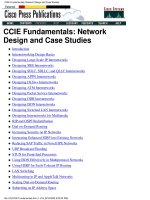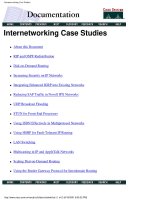Case studies
Bạn đang xem bản rút gọn của tài liệu. Xem và tải ngay bản đầy đủ của tài liệu tại đây (100.51 KB, 16 trang )
FIVE CASE STUDIES
167
FIVE
Case studies
In this section, we will look at a number of organizations and how
they tackled – with varying levels of success – challenges facing their
businesses. Each case study will be followed by a brief outline of key
lessons or insights to be drawn.
The companies featured are as follows:
1. Dell Computer Corporation
2. Encyclopaedia Britannica
3. Seven-Eleven
4. Vermeer Technologies
The organization
By the age of 12, Michael Dell’s entrepreneurial streak was begin-
ning to emerge. That year, he earned $2,000 from selling stamps. By
Dell Computer Corporation
“It’s easy to fall in love with how far you’ve come and
how much you’ve done. It’s definitely harder to see the
cracks in a structure you’ve built yourself, but that’s all
the more reason to look hard and look often. Even if
something seems to be working, it can be improved.”
MICHAEL DELL, CEO, DELL COMPUTER CORPORATION
GURUS ON E
-
BUSINESS
168
the time he was 18, he was selling customized personal computers.
He started the Dell Computer Corporation in 1984 with $1,000, drop-
ping out of his Biology course at Austin University in Texas. The
company, under his leadership, has gone on to become one of the
most successful computer businesses in the world, redefining the indus-
try with its direct-sale approach and the customer support model it
pioneered. Dell himself is a member of the Board of Directors of the
United States Chamber of Commerce and the Computer-world/Smith-
sonian Awards.
The story
Dell Computer Corporation is one of the computer industry’s biggest
success stories. Established in 1984, Michael Dell founded his
company with the unprecedented idea of bypassing the middleman
and selling custom-built computers direct to end users. His premise
from the beginning was to under-promise and over-deliver – and that
applied to customers, suppliers and employees alike.
Originally an ‘offline’ business, Dell was quick to appreciate the poten-
tial of the internet – in fact, he built an e-business before anyone had
even coined the term. Dell.com was a natural extension of the offline
business. The site is customer, rather than product, focused, being
aligned by customer categories, not hardware model lines. The site
directs the different type of customers to a second-level page, where
the relevant line of Dell products is presented.
Pursuing this customer orientation still further, Dell brings customers
into the product-planning and manufacturing processes, not just the
sales process, and management encourages everyone in the company
to have contact with customers.
Here’s how Michael Dell himself characterizes his business approach
in his book Direct from Dell:
• Think about the customer, not the competition: Competi-
tors represent your industry’s past, as, over the years, collective
FIVE CASE STUDIES
169
habits become ingrained. Customers are your future, repre-
senting new opportunities, ideas and avenues for growth.
• Work to maintain a healthy sense of urgency and crisis:
This doesn’t mean that you want to fabricate deadlines or keep
people so stressed that they quickly burn out. Set the bar slightly
higher than you normally would, so that your people can
achieve aggressive goals by working smarter.
• Be opportunistic, but also be fast: Look to find opportunity,
especially when it isn’t readily apparent. Focusing on the
customer doesn’t mean that you should ignore the competi-
tion. If something that your competition did or didn’t do
provided you with an opportunity today, would you recog-
nize it and be able to act on it immediately? Today a competitive
win can literally be decided one day at a time. You have to act
fast, be ready, then be ready to change – fast.
• Be the hunter, not the hunted: Success is a dangerous thing,
as we are at once invincible and vulnerable. Always strive to
keep your team focused on growing the business and on
winning and acquiring new business. Even though your
company may be leading the market, you never want your
people to act as though you are. That leads to complacency,
and complacency kills. Encourage people to think, ‘This is good.
This worked. Now how can we take what we’ve proven and
rise it to win new business?’ There’s a big difference between
asking that and asking, ‘How can we defend our existing
accounts?’
Analysis
Obsessive customer focus linked to strategic savvy and an ongoing
commitment to innovation are clearly instrumental to Dell’s success
over the years, but just as important has been Michael Dell’s commit-
ment to internal organizational processes.
GURUS ON E
-
BUSINESS
170
He has described culture as ‘one of the most enigmatic facets of manage-
ment’ that he has encountered ‘and also one of the most important.”’
When asked which of his competitors represented the biggest threat
to Dell, he said that the greatest threat wouldn’t come from a
competitor, it would come from the people who worked for Dell. His
goal at Dell has been to make sure that everybody at Dell feels they
are a part of ‘something great – something special – perhaps some-
thing even greater than themselves’. To achieve this, he set out from
the beginning to create a company of owners. As he puts it in Direct
from Dell:
‘Creating a culture in which every person in your organization,
at every level, thinks and acts like an owner means that you need
to aim to connect individual performance with your company’s
most important objectives. For us, that means we mobilize every-
one around creating the best possible customer experience and
enhancing shareholder value – and we use specific quantifiable
measurements of our progress towards those goals that apply to
every employee’s performance. A company composed of individual
owners is less focused on hierarchy and who has the nicest office,
and more intent on achieving their goals.’
Simply put, Dell’s approach is about establishing and maintaining a
healthy, competitive culture by partnering with his people through
shared objectives and a common strategy.
This is not just a lofty statement; it is backed up by a set of highly
practical actions. When recruiting, for example, the company looks
for people who are completely in synch with its business philosophy
and objectives. Dell says: ‘If the person thinks in a way that’s compat-
ible with your company values and beliefs, and understands what the
company does and is driven to do, he will not only work hard to fulfil
his immediate goals, but he will also contribute to the greater goals
of the organization.’ That’s not to say that Dell encourages ‘herd’ think-
ing – but that everyone in the company is mobilized around a
customer-oriented focus.
FIVE CASE STUDIES
171
Because of the constant demand for talent, recruiting is a non-stop,
year-round activity, like R&D or sales. The result is a steady pipeline
of talent. Dell doesn’t recruit strictly for job openings: it hires the best
available candidates, even if that means creating a new position. To
quote Andy Esparza, the company’s Head of Staffing, ‘Why would
you choose not to hire a great person just because there’s no job
opening at the present time?’
Dell Computers then has an intensely people-centric culture. For any
company that wishes to emulate the Dell model, there seem to be six
keys to their approach. These can be summed up as follows:
1. Mobilize your people around a common goal.
2. Invest in long-term goals by hiring ahead of the game and
communicating this commitment to your people.
3. Don’t leave the talent search to the human resources section
– get personally involved as much as you can.
4. Cultivate a commitment to personal growth.
5. Build an infrastructure that rewards mastery – the best way
to keep talented people is to allow their jobs to change with
them.
6. Keep in touch with people at all levels of the company – immerse
yourself in real information with real people
The section will conclude with a feature called something like Best
Practice: pulling it all together, in which I will look at what can we
conclude from the case studies in this section.
GURUS ON E
-
BUSINESS
172
e-Bay
The business model of eBay
Traditional corporate strategy centres on establishing defensive
strategic positions, building assets and driving synergies from differ-
ent combinations of assets and/or businesses. Newer models of
strategy, however, stress the quality of the strategic process itself,
which underpins the ability of the organization to define the ‘rules
of the game’ in its industry rather than simply react to them. This leads
to a more organic and dynamic approach to strategy compared with
the traditional approach, which is heavily influenced by the machine
metaphor.
The demand-driven business model of eBay fundamentally changes
the nature of the pricing system and will revolutionize the way compa-
nies (particularly retailers) do business. eBay is a true peer-to peer
model. It facilitates direct exchanges between people who go to its
site to list products for sale or to search listings of products for sale.
The actual exchange takes place between individuals. Just as (music
file-swapping company) Napster provides a central file directory that
allows individuals to swap songs, eBay provides a central listing that
allows individuals to buy and sell merchandise. As with Napster, the
network members can act as either distributor or consumer.
In essence, eBay makes its money by providing a technology plat-
form that enables users to interact with each other and then skims
money off every transaction. This model, like the demand-aggrega-
tion models of other e-pioneers, moves from a fixed ‘take it or leave
it’ price determined by sellers (and based most often on cost) to a
variable price that actually reflects the true value to the customer as
determined by the customers themselves.









